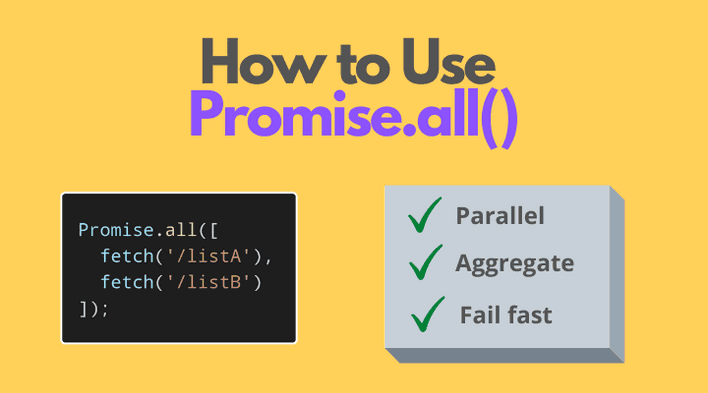A promise is a placeholder for a value that's going to be available sometime later. The promise helps handle asynchronous operations.
JavaScript provides a helper function Promise.all(promisesArrayOrIterable) to handle multiple promises at once, in parallel, and get the results in a single aggregate array. Let's see how it works.
1. Promise.all()
Promise.all() is a built-in helper that accepts an array of promises (or generally an iterable). The function returns a promise from where you can extract promises resolved values using a then-able syntax:
const allPromise = Promise.all([promise1, promise2]);allPromise.then(values => { console.log(values); // [resolvedValue1, resolvedValue2]}).catch(error => { console.log(error); // rejectReason of any first rejected promise});
In the case of async/await syntax:
const allPromise = Promise.all([promise1, promise2]);try { const values = await allPromise; console.log(values); // [resolvedValue1, resolvedValue2]} catch (error) { console.log(error); // rejectReason of any first rejected promise}
The interesting part is in the way the promise returned by Promise.all() gets resolved or rejected.
If all promises are resolved successfully, then allPromise fulfills with an array containing fulfilled values of the promises. The order of promises in the array does matter — you'll get the fulfilled values in the same order.
But if at least one promise rejects, then allPromise rejects right away (without waiting for the remaining pending promises to resolve) for the same reason.
Let's see some examples.
2. Example: all promises fulfilled
To study how Promise.all() works, I'm going to use 2 helpers — resolveTimeout(value, delay) and rejectTimeout(reason, delay).
function resolveTimeout(value, delay) { return new Promise( resolve => setTimeout(() => resolve(value), delay) );}function rejectTimeout(reason, delay) { return new Promise( (r, reject) => setTimeout(() => reject(reason), delay) );}
resolveTimeout(value, delay) returns a promise that fulfills with value after passing delay time.
rejectTimeout(reason, delay), however, returns a promise that rejects with reason (usually an error) after passing delay time.
Let's access, at the same time, the lists of vegetables and fruits available at the local grocery store. Accessing each list is an asynchronous operation:
const allPromise = Promise.all([ resolveTimeout(['potatoes', 'tomatoes'], 1000), resolveTimeout(['oranges', 'apples'], 1000)]);// wait...const lists = await allPromise;// after 1 secondconsole.log(lists); // [['potatoes', 'tomatoes'], ['oranges', 'apples']]
const allPromise = Promise.all([...]) returns a new promise allPromise.
const lists = await allPromise awaits 1 second until allPromise fulfills with an array containing the first and second promises fulfill values.
Finally, lists contains the aggregated result: [['potatoes', 'tomatoes'], ['oranges', 'apples']].
Note that the order of the values in the aggregated result corresponds to the order of the promises in the array supplied to Promise.all():
const [resolvedOfPromise1, resolvedOfPromise2] = Promise.all([promise1, promise2])
3. Example: one promise rejects
Now imagine the situation the grocery is out of fruits. Let's reject the fruits promise with an error new Error('Out of fruits!'):
const allPromise = Promise.all([ resolveTimeout(['potatoes', 'tomatoes'], 1000), rejectTimeout(new Error('Out of fruits!'), 1000)]);try { // wait... const lists = await allPromise;} catch (error) { // after 1 second console.log(error.message); // 'Out of fruits!'}
In this scenario allPromise = Promise.all([...]) returns, as usual, a promise.
After 1 second the second promise rejects with an error new Error('Out of fruits!'). This makes allPromise reject right away with the same new Error('Out of fruits!').
Even if the vegetables' promise has been fulfilled, Promise.all() doesn't take it into account.
Such behavior of Promise.all([...]) is named fail-fast. If at least one promise in the promises array rejects, then the promise returned by allPromise = Promise.all([...]) rejects too — for the same reason.
4. Conclusion
Promise.all([...]) is a useful helper function that lets you execute asynchronous operations in parallel, using a fail-fast strategy, and aggregate the results into an array.
How often do you use Promise.all()?


